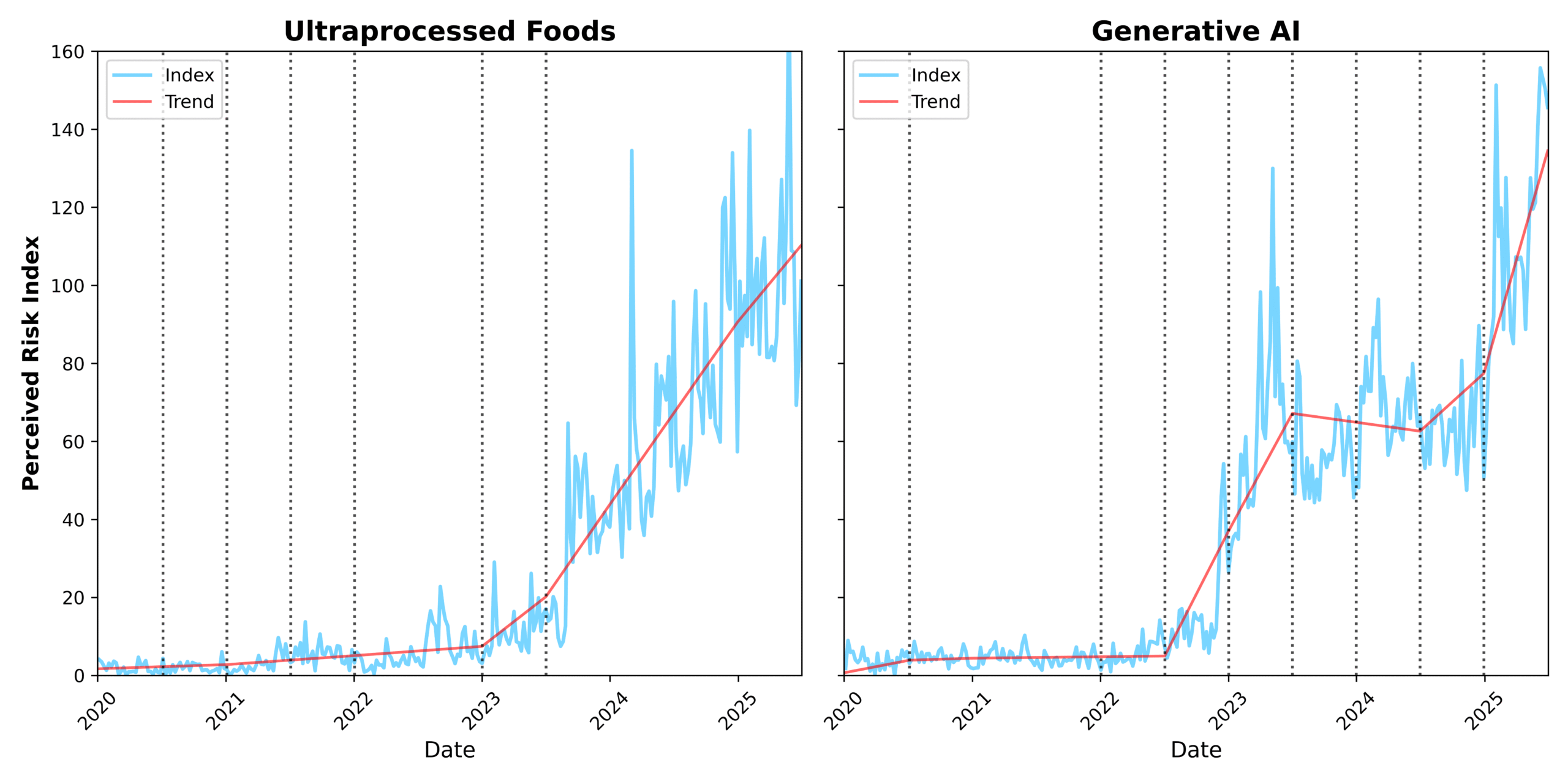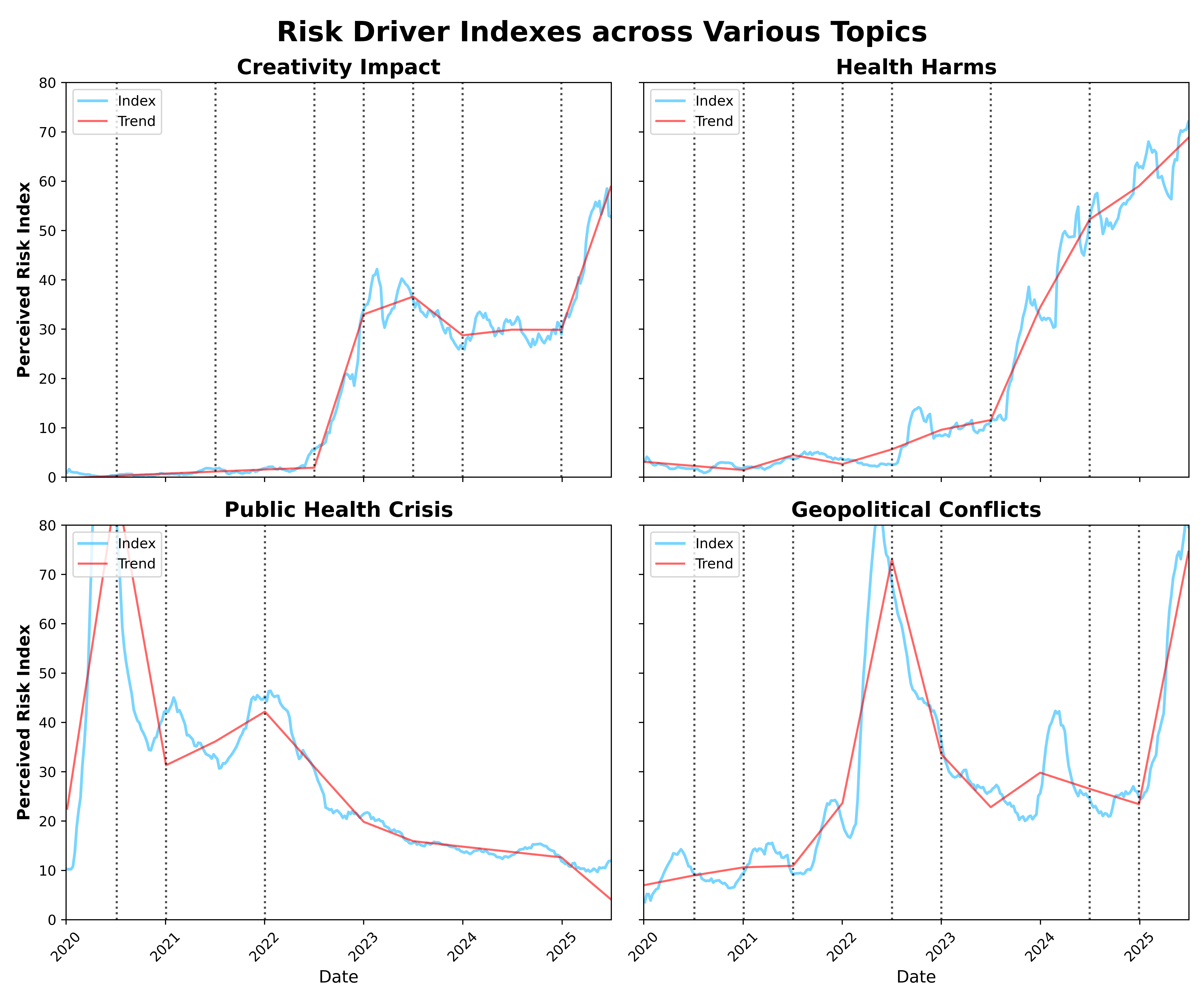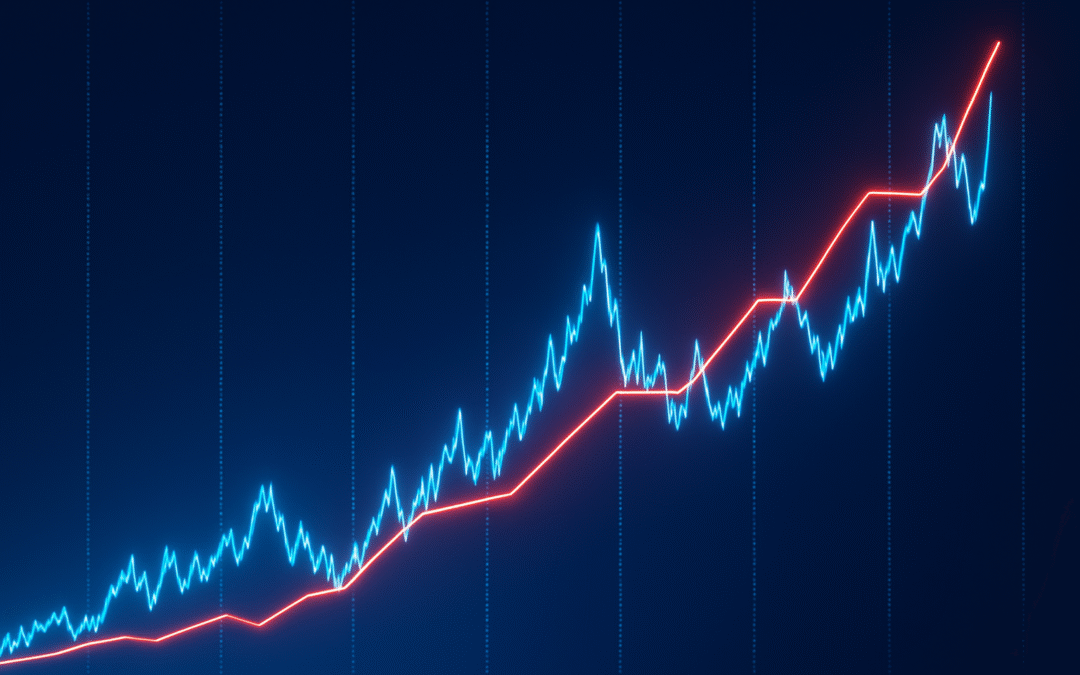Abstract
RiskWise AI translates noisy, cross-channel signals into decision-ready risk intelligence by modeling risk drivers, the causal factors that create or amplify risk, rather than tracking outcomes alone. Our pipeline continuously ingests social, news, academic, and legal data; normalizes and labels content; and aggregates it into RiskWise Risk Indexes that combine severity, frequency, volume, and signal quality. These indexes surface early inflection points and trend shifts, enabling weeks-to-months of lead time before risks materially impact operations or P&L.
Publish Date
October 1, 2025
Authors
The Forces Behind Emerging Risk
Risk often comes in many forms, encompassing any event, condition, or action that threatens a company’s strategic objectives, operational continuity, brand equity, or financial performance. The consequences of not properly managing risk can be wide-ranging. Reputational damage from product recalls or shifting regulatory scrutiny, costly litigation stemming from compliance failures or intellectual property disputes, and significant revenue or market share erosion triggered by supply chain disruptions and other systemic shocks are just a few of the potential outcomes.
The time for risks to materialize varies with some emerging suddenly while others develop gradually over time. They can emerge from a wide range of sources, making them difficult to detect, anticipate, and ultimately manage effectively.
To understand the forces behind these risks, we identify and extract the underlying risk drivers specific to a company’s industry or topic. While risks are the potential outcomes a company is concerned about, risk drivers are the underlying factors that create or amplify risks, giving organizations clarity about why a particular issue poses a threat. Some risk drivers are highly specific to a particular industry or topic, while other risk drivers are more broad and span multiple sectors.
For example, an industry-specific driver might be obesity and its link with ultraprocessed foods, which could ultimately lead to costly litigation and stricter regulatory compliance for companies operating in the ultraprocessed foods industry. A risk driver that spans multiple industries could be geomarket disruptions which are linked to supply chain issues that impact multiple industries and influence a company’s ability to generate sales, reduce costs, and maintain market share.
Building the Risk Index: A New Standard for Risk Measurement
The RiskWise AI Risk Index is a clear, comparable measure of risk, built on mathematical rigor and multi-channel inputs. It integrates factors such as severity, volume, frequency, and signal quality to transform diverse risk signals into a single, quantifiable metric. The process combines a broad range of data sources with a continuous ingestion pipeline that extracts and monitors risk drivers as they emerge in real time.
Client Case Study: Provided in Figure 1 below are two time-series plots of aggregated risk driver indexes constructed from multiple data sources, for two distinct topics: Ultraprocessed foods and Generative AI comprising of 6 and 22 risk drivers, respectively. The indexes capture how risk-related mentions across various data sources change over time relative to the historical time period 2020-2025. The vertical blue dotted line represents distinct time periods where our models detect shifts in emerging trends. While both indexes reveal emerging trends over time, their historical patterns differ. The Ultraprocessed foods index demonstrate a steady, gradual rise, whereas the Generative AI index displays a sharp spike in late 2022, followed by a period of stabilization, and then another recent surge, starting in late 2024, in emerging risks. In both cases, our approach detects early signals of these shifts months before the trend start to sharply increase – early risk signals emerged as far back as 2020 for ultraprocessed foods, and in early 2022 for Generative AI, preceding both the public release of ChatGPT and the broader wave of discourse that began in late 2022.
Figure 1: Riskwise AI Risk Indexes for Ultraprocessed Foods and Generative AI topics

Tickr’s Forward-Looking Approach to Risk Intelligence
Our method for extracting risk drivers is designed to help companies understand how risk signals may materialize into actual risks in real-time. Our framework for identifying risk drivers is distinct in two ways:
(1) Breadth of data – We compile data from a diverse set of sources to capture a complete view of risk drivers. The data we analyze includes consumer-generated content on social platforms (X, Reddit, Bluesky), which reflect real-time public opinions; news coverage from major news outlets (The Guardian, CNN, NPR), which provide authoritative reporting on emerging issues; peer-reviewed research from academic journals (Science, Nature), which identify scientific discoveries and insights that are have been tested; and legal documents (dockets, case filings, jury verdicts, and settlements), which reflect long-term outcomes and disputes. By analyzing narratives from these diverse perspectives, we capture a comprehensive view of risk drivers.
(2) Real-time ingestion and monitoring – Data is continuously ingested and monitored across these sources to track how risk drivers are emerging and evolving over time. In addition, our framework uncovers new risk drivers as more recent data is ingested. With information being disseminated at an extremely fast-pace across all data channels, our system provides real-time analysis to deliver early risk detection and actionable insights before risk drivers fully materialize into adverse outcomes.
Client Case Study: For example, a client was interested in uncovering risk drivers related to Generative AI. We gathered textual data from various data sources over the past few years and reviewed the content to uncover more than twenty risk drivers. These risks drivers range from consumer and individual-focused risks such as job displacement and ethical concerns to business-oriented risks such as intellectual property infringement and reputational damage. Other examples of extracted risk drivers from different topics include health concerns such as cancer and obesity for the ultraprocessed foods industry, and market concentration and geomarket disruption risk drivers emerging from supply chain topics. Each of these risk drivers capture perceived risk signals, which can materialize into actual risks through different mechanisms. Table 1 illustrates how various risk drivers can materialize into different risks that can negatively impact a company’s performance.
Table 1: Example of Topics, Risk Drivers, Potential Risks, and Business Outcomes associated with the potential risks
|
Topic |
Risk Driver |
Potential Risk |
Business Outcome (Actual Risks) |
|
Generative AI |
Ethics Concerns |
Reputational Damage |
Loss in Market Share and Revenue |
|
Generative AI |
IP Infringement |
B2B Litigation |
Increase in Costs, Bankruptcy |
|
Ultraprocessed foods |
Diabetes, Heart Disease |
Stricter Compliance (food labels, ingredient ban) |
Loss in Revenue, Increase in Production Costs |
|
Supply Chain |
Geomarket disruptions |
Tariffs, Economic sanctions |
Increase in Production Costs |
After extracting risk drivers, we label and aggregate the data to create risk driver indexes. Provided in Figure 2 below are several time-series plots of these indexes from various topics, including Generative AI, Ultraprocessed foods, and Supply Chain. The vertical dotted lines highlight data-driven trend shifts that signal when a risk driver is emerging. As noted in the previous section, some risk drivers evolve gradually over time while others exhibit a more sharp increase in a short amount of time.
Figure 2: Time-Series of Select Risk Driver Indexes (12-Week Moving Average)

By tracking changes in risk drivers indexes over time, companies can identify emerging risks before they fully materialize into adverse outcomes. The time-series plots make it easy to observe which risk drivers deserve attention, providing companies with an advantage in either accommodating or preventing an adverse outcome.
As outlined earlier, fully materialized risk is any event, condition, or action that can disrupt a company’s objectives, operations, reputation, or financial performance. Gaining early visibility into these emerging risks enables companies to protect revenue, reduce costs, and build long-term resilience. The RiskWise AI risk indexes make this foresight possible, where companies gain weeks or even months of early risk detection before a risk materializes into a negative event.
Anticipating Disruption Before it Disrupts You
As change accelerates and information spreads more rapidly, structured risk monitoring is no longer optional. Organizations that consistently capture, analyze, and interpret risk signals can better mitigate shocks, protect revenue, and avoid costly disruptions.
The question is: which risk drivers should you be tracking to anticipate the next major disruption to your industry? How effectively are you incorporating multiple data sources to surface new and emerging risks before they fully materialize?
RiskWise aggregates these diverse data streams and extracts insights that reveal emerging threats. Schedule a RiskWise Demo and we’ll show you how.


